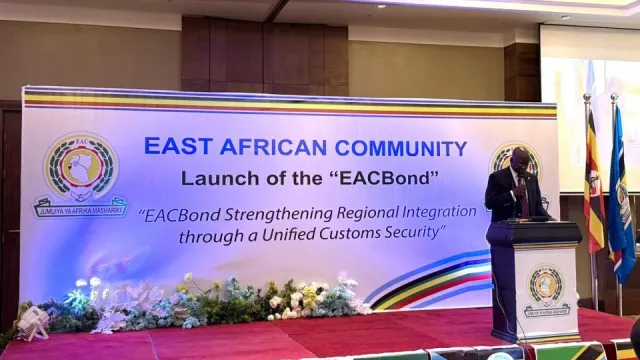Regional bloc bets big on EACBond to cut costs, boost cross-border trade

By allowing traders to secure their entire cargo journey with a single bond, the EACBond is poised to significantly reduce trade costs, ease border delays and free up business capital.
The East African Community (EAC) has launched the EACBond, a regional customs guarantee instrument tailored to replace the need for multiple national bonds when transporting goods across Partner States, allowing traders to secure their entire cargo journey with a single bond.
EACBond eliminates repetitive requirements by providing one bond that secures the entire movement of goods across EAC member countries.
This strategy, therefore, is poised to simplify customs clearance, cut operational expenses for cross-border traders and allow businesses to reinvest their working capital into expansion and, therefore, creation of jobs.
A customs bond is a financial guarantee that ensures the government can recover duties or taxes if a trader fails to comply with customs regulations.
Traditionally, traders moving goods from the Port of Mombasa to regional destinations such as Kampala or Kigali are required to post separate bonds or provide cash deposits at every border crossing, a practice that locks up capital at each step, therefore, pushing up the cost of trade.
It is, therefore, music in the ears of traders as EACBond is poised to significantly reduce the cost of trade, ease persistent delays at border crossings and boost enterprises by freeing up vital capital for business.
The bond is set to lower trade costs by removing multiple bond charges at borders, ultimately making goods more affordable for consumers, explained EAC Secretary General Veronica Nduva during the launch.
Free up money tied in deposits
“The EACBond frees up traders’ money that was tied up in deposits, allowing businesses to reinvest in expansion and jobs. It also improves trade transparency through real-time tracking, reducing fraud and cargo diversion,” she stated.
EACBond was launched in Kampala, Uganda, at an event attended by government representatives, logistics firms, banks, insurance providers and customs officials.
The pilot phase will be undertaken on cargo moving between Kenya, Uganda and Rwanda with full rollout set to include all EAC partner states.
In an update, EAC said compliance will be enforced through automated systems linked with customs and cargo tracking, ensuring that all movements are monitored and managed.
Nduva explained that the bond streamlines customs clearance procedures and firms up government revenue collection by ensuring compliance and automating risk checks.
“Each year, over $35 billion worth of goods move through our regional corridors. Yet, much of this trade has been constrained by high financial guarantees and complex border procedures. The EACBond simplifies compliance, reduces operational costs and unlocks your working capital,” she added.
She also noted that nearly $2 billion in previously tied-up capital will now be released back into the economy through digital guarantees, creating new opportunities in production, logistics, job creation and innovation.
The launch comes at a moment of strong growth in intra-regional trade. The EAC Quarterly Statistics Bulletin for the period January to March 2025 shows that total exports increased by 47.3 percent to about KES2.3 trillion ($17.7 billion) while imports rose by 4.6 percent to KES2.2 trillion ($16.8 billion).
Furthermore, domestic exports grew by 48.1 percent and re-exports rose by 32.4 percent, reflecting an increase in locally produced and value-added goods.
This has been attributed to the growth of the Intra-African trade during the period. In the first quarter of 2025 alone, intra-EAC trade surged by 53.6 percent to about KES672 billion ($5.2 billion), representing nearly 28 percent of the region’s total trade.
Fastest growing markets
Kenya has emerged as a dominant player in the bloc with exports to EAC countries accounting for 21 percent of its total exports, with the Democratic Republic of Congo overtaking Uganda and Tanzania to become one of its fastest-growing markets.
However, non-tariff barriers and customs inefficiencies continues to undermine trade, a matter that the EACBond aims to address.
“The EACBond is a game changer for our traders. By eliminating multiple bond requirements, we are cutting unnecessary costs and speeding up trade across our borders. This will empower our business community, boost Uganda’s exports, and strengthen our participation in the regional economy,” Uganda’s Minister of State for East African Community Affairs, James Magonde Ikuya, stated.
On her part, EAC Deputy Secretary General for Customs, Trade and Monetary Affairs Annette Ssemuwemba Mutaawe noted that the EACBond is the result of a decade-long effort to establish a unified regional customs guarantee framework aligned with the bloc’s Customs Union and Single Customs Territory.
“Developed through a phased, consultative process, this bond reflects the collective resolve of governments and private sector partners to ease trade and unlock economic opportunities across East Africa,” she said.
EACBond is a key component of a wider digital trade facilitation infrastructure that connects customs, insurance, banking, ports and cargo tracking systems across the region.





